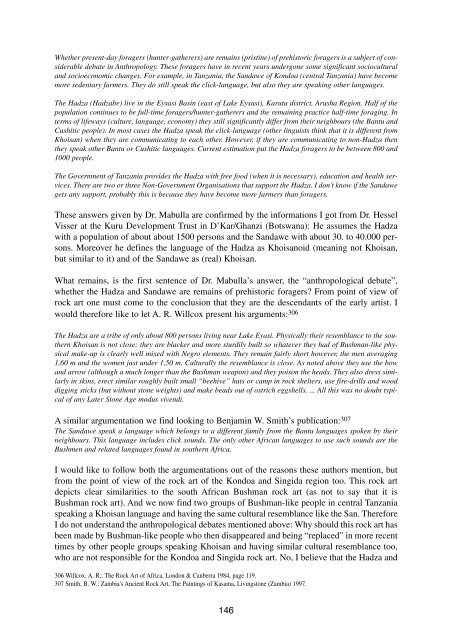1.) schw.weiss - StoneWatch
1.) schw.weiss - StoneWatch
1.) schw.weiss - StoneWatch
Create successful ePaper yourself
Turn your PDF publications into a flip-book with our unique Google optimized e-Paper software.
Whether present-day foragers (hunter-gatherers) are remains (pristine) of prehistoric foragers is a subject of considerable<br />
debate in Anthropology. These foragers have in recent years undergone some significant sociocultural<br />
and socioeconomic changes. For example, in Tanzania, the Sandawe of Kondoa (central Tanzania) have become<br />
more sedentary farmers. They do still speak the click-language, but also they are speaking other languages.<br />
The Hadza (Hadzabe) live in the Eysasi Basin (east of Lake Eysasi), Karutu district, Arusha Region. Half of the<br />
population continues to be full-time foragers/hunter-gatherers and the remaining practice half-time foraging. In<br />
terms of lifeways (culture, language, economy) they still significantly differ from their neighbours (the Bantu and<br />
Cushitic people). In most cases the Hadza speak the click-language (other linguists think that it is different from<br />
Khoisan) when they are communicating to each other. However, if they are communicating to non-Hadza then<br />
they speak other Bantu or Cushitic languages. Current estimation put the Hadza foragers to be between 800 and<br />
1000 people.<br />
The Government of Tanzania provides the Hadza with free food (when it is necessary), education and health services.<br />
There are two or three Non-Government Organisations that support the Hadza. I don’t know if the Sandawe<br />
gets any support, probably this is because they have become more farmers than foragers.<br />
These answers given by Dr. Mabulla are confirmed by the informations I got from Dr. Hessel<br />
Visser at the Kuru Development Trust in D’Kar/Ghanzi (Botswana): He assumes the Hadza<br />
with a population of about about 1500 persons and the Sandawe with about 30. to 40.000 persons.<br />
Moreover he defines the language of the Hadza as Khoisanoid (meaning not Khoisan,<br />
but similar to it) and of the Sandawe as (real) Khoisan.<br />
What remains, is the first sentence of Dr. Mabulla’s answer, the “anthropological debate”,<br />
whether the Hadza and Sandawe are remains of prehistoric foragers? From point of view of<br />
rock art one must come to the conclusion that they are the descendants of the early artist. I<br />
would therefore like to let A. R. Willcox present his arguments: 306<br />
The Hadza are a tribe of only about 800 persons living near Lake Eyasi. Physically their resemblance to the southern<br />
Khoisan is not close: they are blacker and more sturdily built so whatever they had of Bushman-like physical<br />
make-up is clearly well mixed with Negro elements. They remain fairly short however, the men averaging<br />
1,60 m and the women just under 1,50 m. Culturally the resemblance is close. As noted above they use the bow<br />
and arrow (although a much longer than the Bushman weapon) and they poison the heads. They also dress similarly<br />
in skins, erect similar roughly built small “beehive” huts or camp in rock shelters, use fire-drills and wood<br />
digging sticks (but without stone weights) and make beads out of ostrich eggshells. ... All this was no doubt typical<br />
of any Later Stone Age modus vivendi.<br />
A similar argumentation we find looking to Benjamin W. Smith’s publication: 307<br />
The Sandawe speak a language which belongs to a different family from the Bantu languages spoken by their<br />
neighbours. This language includes click sounds. The only other African languages to use such sounds are the<br />
Bushmen and related languages found in southern Africa.<br />
I would like to follow both the argumentations out of the reasons these authors mention, but<br />
from the point of view of the rock art of the Kondoa and Singida region too. This rock art<br />
depicts clear similarities to the south African Bushman rock art (as not to say that it is<br />
Bushman rock art). And we now find two groups of Bushman-like people in central Tanzania<br />
speaking a Khoisan language and having the same cultural resemblance like the San. Therefore<br />
I do not understand the anthropological debates mentioned above: Why should this rock art has<br />
been made by Bushman-like people who then disappeared and being “replaced” in more recent<br />
times by other people groups speaking Khoisan and having similar cultural resemblance too,<br />
who are not responsible for the Kondoa and Singida rock art. No, I believe that the Hadza and<br />
306 Willcox, A. R.: The Rock Art of Africa, London & Canberra 1984, page 119.<br />
307 Smith, B. W.: Zambia's Ancient Rock Art, The Paintings of Kasama, Livingstone (Zambia) 1997.<br />
146
















